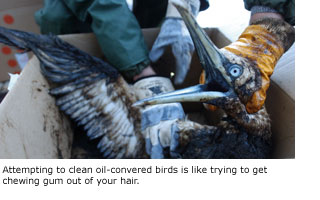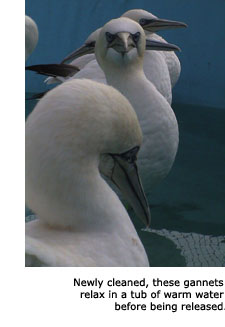 |
| |
An Injured Bird's In November when the Prestige oil tanker split and sank just off Spain's Galician coast, Chris Battaglia (B.A., Psychology, '90) left his post at the Northern California International Bird Rescue Research Center and hopped on a plane bound for Pontevedra, Spain. Hours later he surveyed a shoreline littered with abandoned shovels and buckets. "People had tried to clean the water and rocks along the coast but there was just too much oil," he says. "It looked like a war zone." Battaglia, the center's education director, joined a handful of international experts who came to save potential casualties: hundreds of gulls, gannets, razorbills, and Atlantic puffins, weak and weary and covered in oil. As the SFSU alum explains it, bird feathers work like shingles on a house. When the feathers are interlocked, they keep an aquatic bird waterproofed and warm. When covered in oil, feathers collapse the layer of warm air underneath. Oil-covered birds can't regulate their body temperature or dive for food. Without intervention from wildlife experts, survival is highly unlikely. In Spain, Battaglia set up a makeshift bird hospital at an abandoned fire station, converting the men's room into a bird-washing station. He directed a team of 10 Spanish carpenters in building shelters and cages, and taught the town's volunteers the proper techniques for cleaning birds. Rainstorms persisted as the team treated and monitored birds 15 hours a day. Battaglia struggled to keep outdoor shelters covered and watertight. The stormy weather made search and rescue missions impossible, but 600 birds made it to shore and underwent treatment during his two-month stay. In January, 180 of these birds were rehabilitated and released. As an undergrad, Battaglia planned on a career in family counseling. One volunteer experience at the 1988 Shell oil spill in Martinez, Calif., during his junior year and he knew he'd found his calling. The next year, Battaglia flew to Alaska to help birds in the Exxon Valdez oil spill. "My professors were very understanding," he remembers. "They faxed notes to me so I'd be ready for final exams." Although he wishes more birds could have been saved in Spain, other rescue operations have proven more successful. In June 2002 when the bulk ore carrier MV Treasure sank off the coast of Cape Town, South Africa, Battaglia helped treat and release 18,000 African penguins. For more information: www.ibrrc.org | ||


